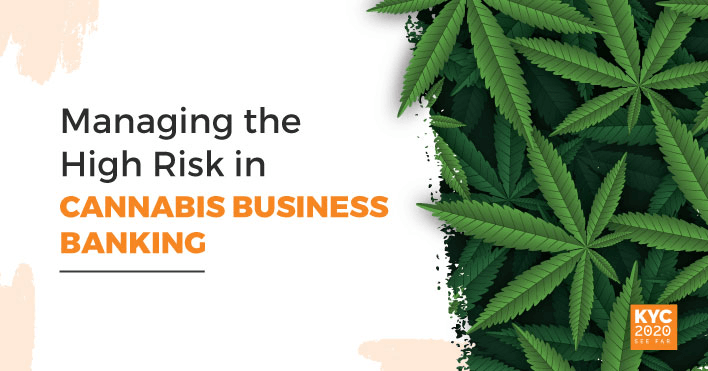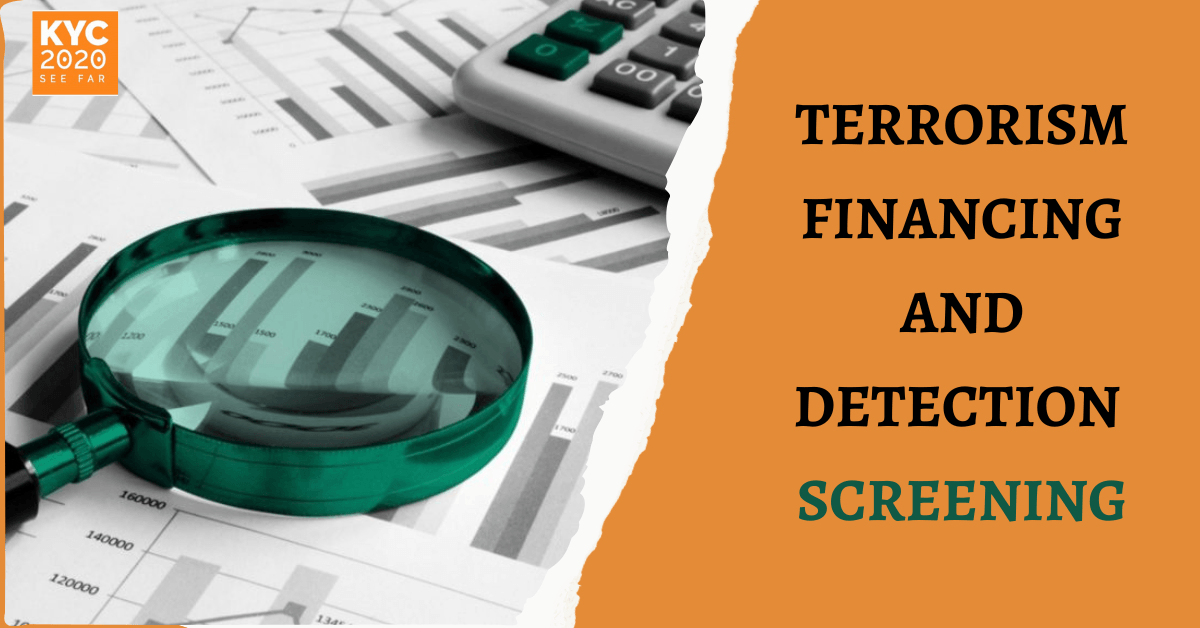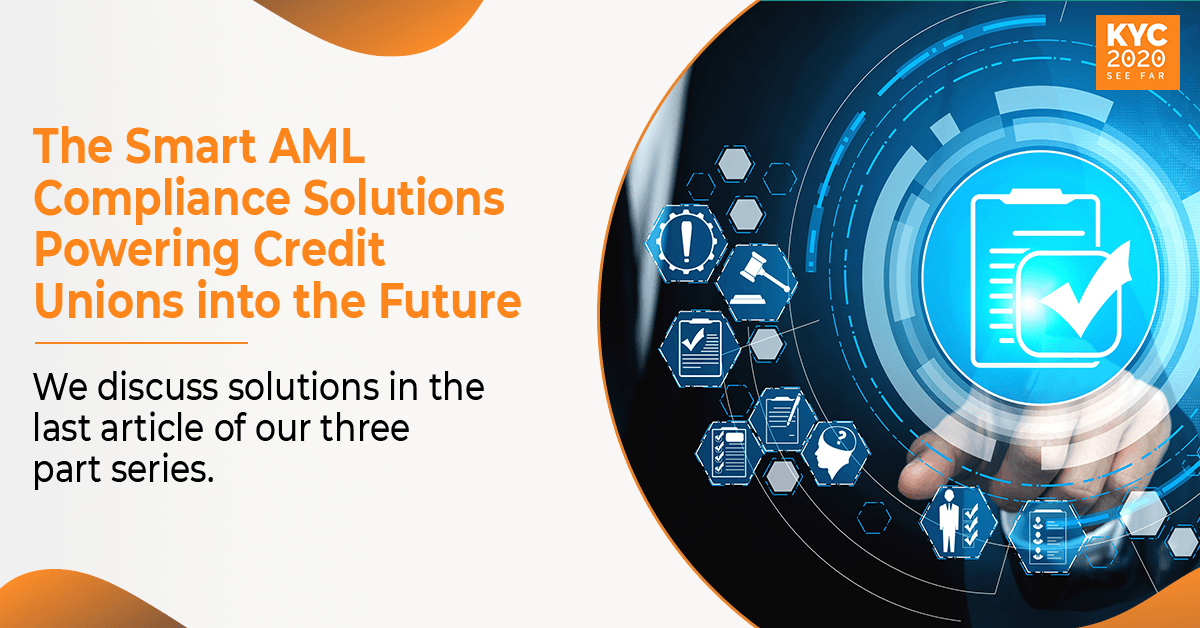The very first step your financial institution must take when servicing the Cannabis business industry is to correctly identify if the business or the beneficial owner is high risk.
In an effort to increase loans and deposits and expand their customer base, smaller financial institutions and credit unions have been considering whether or not to work with cannabis-related businesses. It’s a decision that should not be taken lightly. Servicing this customer pool will in some cases greatly increase your institution’s risk profile. It also entails significantly more scrutiny around Anti-Money Laundering/Bank Secrecy Act (AML/BSA) compliance.
Whether or not you decide to bank a cannabis-related entity, before your institution can even open its doors to this emerging market, there are two elements of your AML compliance regime in particular that you need to focus on:
- A thorough risk assessment
- A rock-solid onboarding process from start to finish
Much regulatory, legal and reputational damage can be averted right from the beginning when you have access to intelligent data, can automate screening processes, and can combine this with good KYC policies and systems.
A Brief Overview of the Cannabis Business Industry
One of the biggest challenges of cannabis business banking is that the Cannabis industry itself as well as the rules that guide it are incredibly diverse and extensive. For starters, cannabis products actually fall into one of three categories: hemp, Cannabidiol (CBD) oil, and marijuana. Each one of these categories is treated differently from a legal and regulatory standpoint. Complicating matters, there are also differences in the rules and regulations from one state to another.
Here is a brief rundown of each type of Cannabis product, including its current legal and regulatory standing:
Hemp
Hemp is a variety of the Cannabis sativa plant species that is grown specifically for commercial use. Hemp produces a broad range of cannabinoids, including tetrahydrocannabinol (THC), the intoxicating chemical in marijuana. Hemp, however, does not contain enough THC to produce intoxicating effects.
Many countries differentiate hemp from marijuana by the amount of THC produced by the plant. In the US, industrial hemp must not contain more than 0.3% THC.
Hemp has a variety of uses. Hemp fibers can be used to make an assortment of products including paper, clothing, textiles, rope, building materials and compost. Hemp seeds and the oil produced from them, on the other hand, can be consumed as healthy, nutrient-rich, super food.
CBD Oil
CBD oil comes from the flower and leaves of the hemp plant. It is not the same as hemp seed oil, which comes from the seed and contains little to no CBD. Over the past few years, there has been a growing demand for CBD oil as a wellness supplement to such an extent it is a sub-industry all to itself.
Both hemp and products containing CBD oil are treated the same from a legal and regulatory standpoint. CBD is also subject to Food and Drug Administration (FDA) oversight with respect to how products containing CBD can be advertised.
According to the 2018 Farm Bill, growing, processing and selling hemp and hemp derivatives is legal at the federal level, and so is transporting hemp across state lines.
There are, however, many restrictions placed on such activities. For instance, all growers, processors and dealers must be approved, registered and/or licensed by the U.S. Department of Agriculture (USDA). Hemp that is not produced in accordance with the 2018 Farm Bill is designated as illegal marijuana.
For financial institutions in particular, the Financial Crimes Enforcement Network (FinCEN) recently issued their guidance regarding due diligence requirements under the Bank Secrecy Act (BSA) for hemp-related business clients.
Marijuana
Marijuana is the dried leaves and flowering tops of either the cannabis sativa or cannabis indica plant. Since marijuana contains a significant amount of the psychoactive substance THC, it is still considered a Schedule 1 substance under federal law. Many states, however, have legalized the cultivation and selling of medical and/or recreational marijuana.
This odd contradiction between federal and state law has brought about two indirect, yet consequential results:
- Marijuana is primarily a cash-based industry since most payment networks will not process marijuana-related transactions.
- Many big marijuana companies rely on the investments of foreign individuals and entities.
Marijuana-related businesses (MRBs) can also be classified into one of two tiers:
- Tier I MRB- A company that is directly involved in cultivating or dispensing marijuana
- Tier II MRB- A company that supports Tier I MRBs, such as hydroponic suppliers, packaging suppliers, licensing consultants, or marijuana software providers
Although cannabis business banking may be challenging in the current environment, it represents a potentially lucrative emerging industry for financial institutions. With total sales of cannabis in the states where it is legal expected to reach nearly $30 billion by 2025, a growing number of cannabis-related businesses are seeking access to mainstream financial products.
Moreover, cannabis products derived from Hemp and CBD are both federally legal and considerably less taboo. This means that institutions looking for untapped markets, could get their foot in the door with less risk and uncertainty.
With MRBs, currently 36 states have legalized the distribution of medicinal and/or recreational marijuana. The largest draw for both banks and credit unions in this high-risk market is the vast untapped potential. Like any business, MRBs need access to financial services in order to survive and expand. The MRB industry, however, is expected to reach a staggering $57 billion by 2027, yet a majority of MRBs (70 percent in total) remain unbanked or under-banked.
Understanding Cannabis Business Banking Risk
Whether or not your financial institution chooses to bank hemp, CBD, or MRB customers, your will be making a risk-based business decision. There are three main areas of risk to consider right from the start:
The Risk Posed by the Cannabis Business
As mentioned above, the risks associated with banking hemp companies versus CBD companies versus MRBs all differ tremendously. Not only would you potentially need to stay updated with the current legal and regulatory status of hemp, CBD and marijuana businesses across several different regions, but there are serious know your customer (KYC) risks, too.
The big risk in banking hemp or CBD companies is that either:
- The hemp involved is actually marijuana
- The hemp or CBD company has not followed all legal requirements, such as having the correct licenses and registrations, or it is growing the hemp in a tract of land that has not been approved.
Support services provided by third parties to cannabis businesses, such as hemp testing facilities, may also put financial institutions at risk for money laundering schemes. These types of companies, however, generally do not pose the same amount of risk as direct cannabis businesses, such as farmers, processors, and dealers.
With cash-oriented MRBs, financial institutions face the real risk of legal action for money laundering and aiding and abetting in drug trafficking. But, that’s not all. Some legal MRBs are committing fraud or opening up shell companies just to gain access to the services of a financial institution. For example, an MRB may list itself as a “pharmacy”, “nursery” or “wellness center” in order to get through the onboarding process.
Risk Posed by the Beneficial Owner
Aside from the typical risk associated with politically exposed persons (PEP) or those with a criminal background, one of the biggest risks surrounding the beneficial owners of a cannabis-related business is figuring out who they are in the first place. The challenge is even greater when determining the true beneficial ownership of marijuana companies due to the prevalence of foreign investment and the prolific use of management agreements and shell companies in the industry.
Risk Posed by the Financial Product
The final area of risk to consider is that posed by the desired financial product(s). The risk to offer a deposit account differs greatly from the risk of providing a loan. Once you’ve determined the risk of the cannabis business itself and of the beneficial owner, making this decision depends on your institution’s risk appetite.
Mitigating the High Risk of Cannabis Banking from the Beginning
A great deal of mitigating the risk of cannabis business banking happens at the beginning, before a client has completed the onboarding process. There are two key steps and areas of focus your financial institution should be concerned about:
Conducting a Risk Assessment
After becoming familiar with the relevant laws and regulations across your institution’s entire footprint, you should conduct a cannabis-risk assessment and set your institution’s risk appetite for the industry. The risk assessment process with the aid of AML Compliance tools and consulting will provide an opportunity for your financial institution to see if cannabis business banking products and services truly fall within the scope of its strategy and risk appetite.
A significant part of your institution’s risk management starts with good KYC practices and systems. Thus, the risk assessment process should confirm whether there is adequate infrastructure and support in place in your AML compliance program. For instance, how is your institution scanning watchlist data, which alternative data sources will you be consulting, and how will matches be sorted and verified?
When evaluating any higher risk activities, the legal and regulatory impact should also be considered in terms of both AML/BSA compliance and potential exposure to litigation.
Developing a Thorough Onboarding Process
The Onboarding process starts with the onboarding request, followed by data capture and initial CDD/CIP, and then enhanced due diligence (EDD) for KYC. This is where much of your risk management and AML compliance happens in practice.
After conducting a risk assessment, you then need to set the risk-rating criteria and processes for risk-rating new customers. Here are a few important considerations:
- Use a comprehensive application and onboarding questionnaire to understand the nature of the business and its financial activity and to secure the necessary documentation, such as the business’ registration and license information. Because banking hemp or CBD is different from marijuana businesses, it’s good practice to have different onboarding questionnaires for each of the three types of cannabis products.
- Invest in automated onboarding technology powered by artificial intelligence and machine learning. These technologies can help your institution conduct enhanced due diligence and deep web searches for automating EDD. You’ll have better insight into the background of each business and its beneficial owners. Moreover, automated platforms such as our own DecisionIQ will not only screen for sanctions, PEP, criminal records, negative news media and more, but create an intelligent scoring engine that reduces manual processes and False Positives.
- Developing an onboarding process that reflects your risk appetite should always be considered a work in progress that you periodically return to and adjust where needed. This reevaluation process will also help your institution conduct its ongoing monitoring for suspicious activity.
In short, banking cannabis-related companies raises the level of risk for any financial institution. But your institution can mitigate the high risk in cannabis business banking by getting your onboarding process, systems and procedures in line with your risk appetite and financial goals.
.
.







